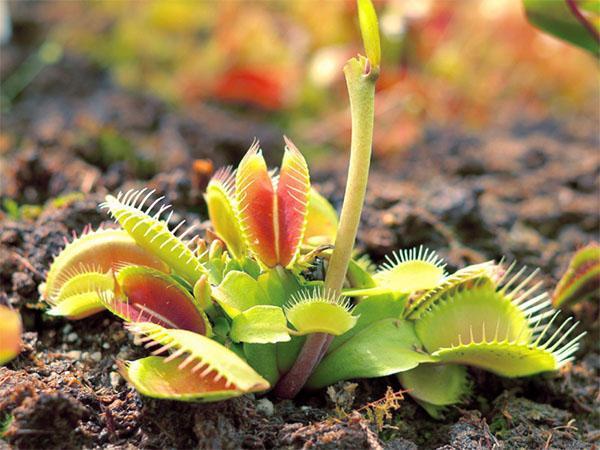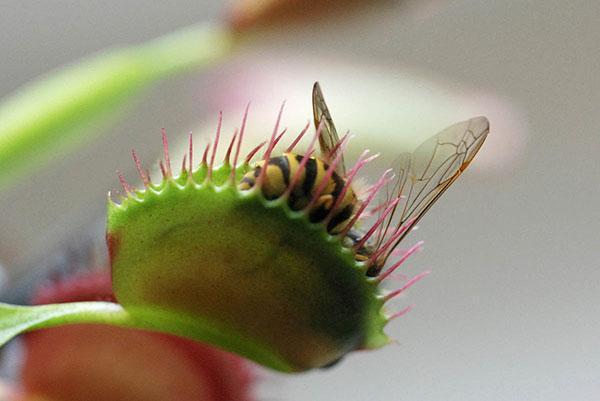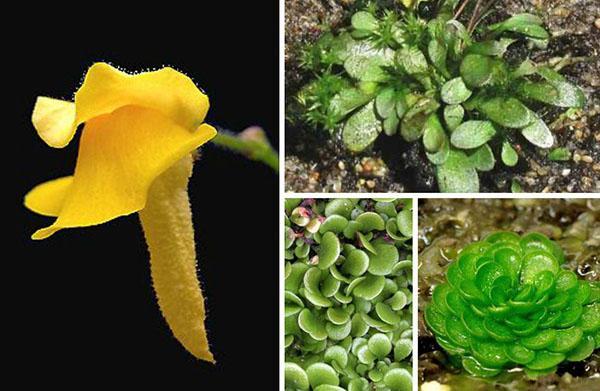Carnivorous plants in the wild and at home
 Predatory plants have been of interest to people for a very long time. Despite the fact that these flowers exist in the real world, in literature, filmography, video games, their abilities are greatly exaggerated. What are carnivorous plants, the main species and their features, we read in this article.
Predatory plants have been of interest to people for a very long time. Despite the fact that these flowers exist in the real world, in literature, filmography, video games, their abilities are greatly exaggerated. What are carnivorous plants, the main species and their features, we read in this article.
What do predators eat?

The enzymes of the flower quickly dissolve the body of the insect, but the skeletons remain undigested. In this regard, the remains of victims are often observed inside the opened buds.
Predatory plants grow on poor soils. Because of this, they are found in different countries.
Depending on the mechanism of catching prey, predator plants are divided into five subspecies:
- Flowers that catch insects with sticky leaves.
- Representatives with jug-shaped containers. The capture of the victim is made using a folded sheet. In some species, its surface is covered with bacteria. There are also plants with digestive enzymes.
- Catching of victims is carried out by suction into a vacuum bubble.
- Plants that catch prey with flapping leaves.
- Flowers with crab claw-shaped traps. The principle of their work is aimed at ensuring that the victim is gradually directed to the site with digestive enzymes.
Carnivorous plants can not only digest insects, but also extract nutrients from them.
All plant traps are divided into passive and active. It can be recognized by the shape of the flowers.
The main varieties of carnivorous plants
Among the large number of species of carnivorous plants, only a few specimens attracted the attention of flower growers.
Carnivorous plant genlisea (Genlisea)
 This variety includes more than 20 varieties. Genliseya grows well in wet soil and at high air humidity. The homeland of such a plant is the southern and central parts of America, Africa.
This variety includes more than 20 varieties. Genliseya grows well in wet soil and at high air humidity. The homeland of such a plant is the southern and central parts of America, Africa.
The flower belongs to the group of low-growing plants. Genlisea has colorful, deep yellow buds. In this species, the trap is presented in the form of a crab claw. Thanks to this structure, the flower is very easy to capture the victim, which, with all the desire, will not be able to get out.
Basically, the habitat of predatory plants is Australia, Southeast Asia, North America.
Genlisea differs from other carnivorous plants in leaves. This flower has two types. The first is the standard plates responsible for photosynthesis. The second type is predatory, which are found in the soil. They are engaged in catching insects and protozoa. It should be noted that in this plant, predatory leaves are responsible for the functions of the rhizome. They absorb moisture, useful components, and also perform the function of fastening.
Predatory leaves that are in the soil form the so-called hollow spiral tubes. Insects and protozoa get into them along with the water stream, and they can't get out back.
Plant Biblis (Byblis)
 Biblis also refers to carnivorous plants. His homeland is the lands of Australia. Biblis is often called the rainbow plant by the locals. All this thanks to the colorful slime on the deciduous plates.Under the sun's rays, it is capable of shimmering in various shades.
Biblis also refers to carnivorous plants. His homeland is the lands of Australia. Biblis is often called the rainbow plant by the locals. All this thanks to the colorful slime on the deciduous plates.Under the sun's rays, it is capable of shimmering in various shades.
This view looks like sundew... However, biblis is not a relative, even their flowers are different. The leaves of this plant are long and cone-shaped. Villi grow on their surface, secreting a sticky composition. It is these villi that catch insects that land on the surface.
Aldrovanda vesiculosa (Aldrovanda vesiculosa)
 This plant also has no root and belongs to predators. She chooses small aquatic animals as victims. The plant has a trap that serves as a trap.
This plant also has no root and belongs to predators. She chooses small aquatic animals as victims. The plant has a trap that serves as a trap.
Aldrovanda feels good in the water. Its stems calmly swim, looking for prey. The length of the shoots, on average, is 10 cm. The leaves are a so-called rosette. They are small, only 1.5-4 mm. The plant catches its prey thanks to the plates on which there are hairs.
The ability to swim appeared in the plant due to the presence of air in the petioles. The plant grows and reproduces very quickly. It can increase by 5-8 mm per day. A new curl appears every day.
The plant grows on one side of the stem, and the second part gradually dies off.
Trap leaves have two parts. They close over the victim from two sides. The trap can catch anyone insect, which floats close to the plant due to the villi located outside. For a full-fledged slamming, the flower needs only a few milliseconds.
Sarracenia
 Sarracenia or North American carnivorous plant:
Sarracenia or North American carnivorous plant:
- Also belongs to the group of predators.
- The flower grows in the southeast of America and in Canada.
- The trap of the plant is the leaves that create something like a water lily. There is a "hood" on top of each such container. It protects the trap from rain falling into it.
- To catch an insect, the plant emits a special smell and also has an attractive color.
Along the edge of the water lily, there is a special substance that acts like a drug on animals. Having descended to the edge of the water lily, they can no longer get out, gradually dying. Further, digestion takes place with the help of enzymes.
Water can negatively affect the digestive juice that is in the water lily.
General info for Nepentes
 It is also a predator. Like sarracenia, nepentes uses a water lily of leaves to lure insects.
It is also a predator. Like sarracenia, nepentes uses a water lily of leaves to lure insects.
This plant includes more than 100 varieties. In the natural environment, they can be found in India, Indonesia, China, Madagascar, the Philippines, Australia and many other countries.
The plant has another name - "monkey cup". It received this name due to the fact that earlier animals used this flower as a container for drinking water. Outwardly, the plant resembles large lianas, the roots of which are quite small. The plant grows in length up to 16 meters.
The trap of nepentes is a leaf with a tendril, at the tip of which a water lily is formed.
- The container opens up at the top, forming a trap.
- A sticky watery liquid is released inside it, which attracts insects.
- Once in it, they drown and are digested by the plant.
- At the bottom of the water lily there are glands that serve to carry nutrients.
Small species of nepentis are engaged in catching insects, and their larger representatives feed on small animals, for example, rats.
Predatory plants are outwardly quite unique and recognizable. Therefore, they are easy to find among other representatives of the fauna. Knowing the features of such flowers, their external characteristics and the main care measures, you can choose exactly the type that will fit into your room and your lifestyle.